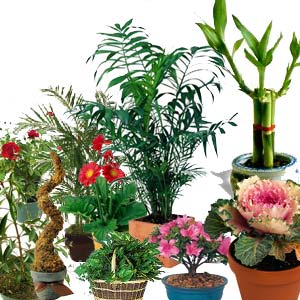Ornamental plant
Ornamental plants are cultivated plants that are cultivated by man for the edification, or for assigned plantings. Ornamental plants are cultivated by gardeners specializing in ornamental horticulture (flowering potted plants, leaf and foliage plants, cut flowers, bedding and balcony plants) Nursery ( ornamental trees, shrubs, perennials ) and Staudenbau ( ornamental shrubs ).
Ornamental plants are a hobby of many people. Often they deal with different groups of plants. Some examples: cacti, orchids, bulbs, fuchsias. There are associations ( plant communities ) in which the interested parties can exchange information and plant material to the respective groups.
Ornamental plants can be broadly divided into the following categories:
- 8.1 Ornamental Shrubs
- 8.2 ornamental trees
Houseplants
Houseplants are plants that can be kept due to their size and environmental claims inside housing rooms or larger rooms. One case is different:
Flowering pot plants
Plants that are cultivated for their flowers Schmucks ( small selection; wide selection at: Houseplant ):
- Cyclamen (Cyclamen persicum - hybrids )
- African violets ( Saintpaulia ionantha )
- Orchids (Orchidaceae) - but only a few genera, species and varieties are suitable for room culture.
Green or leafy plants
Foliage plants are plants that are grown for their beautiful leaves ( small selection: large selection at: Houseplant ):
- Delicious Cheese Plant ( Monstera deliciosa)
- Room - palms ( Arecaceae, different a few genera and species are suitable for room culture. )
- Araucaria (Araucaria excelsia )
Representatives of both groups are to be found both in soil culture as well as in hydroponics.
Bedding and balcony plants
These are often only one or two- year ( but there are also representatives such as woody subshrubs ), find their use in window boxes, borders, tubs and flower beds and are also usually cultivated for their flowers or inflorescences.
- Pelargoniums, often wrongly called geraniums ( Pelargonium Zonal hybrids ), ( Pelargonium peltatum hybrids), ( Pelargonium grandiflorum hybrids )
- Fuchsia ( Fuchsia Cultivars )
- Petunias ( flowers funnel )
- Fan flower ( Scaevola aemula )
Container Plants
Cut flowers
Cut flowers are ornamental plants that are cultivated by gardeners for decorative plants or shrubs Gardening for the cut and are used in floristry in bouquets and flower arrangements:
- Chrysanthemums (Chrysanthemum, Dendranthema )
- Carnations (Dianthus )
- Roses ( Rosa hybrids )
- Alstroemeria
Bulbous and tuberous plants
These are ornamental plants, which sprout after a winter rest from bulbs or tubers and usually only bloom in the spring. Bulbous and tuberous plants also have showy flowers or inflorescence jewelry.
- Tulip (Tulipa hybrids )
- Daffodil (Narcissus pseudonarcissus )
- Hyacinth ( Hyacinthus orientalis)
- Ritterstern ( Hippeastrum hybrids Vitatum )
- Clivia ( Clivia miniata )
Ornamental shrubs
General, see: perennial
- Hosta
- Forget -me-not
- Peony
Ornamental grasses
- Sedges ( Carex sp.)
- Fountain grass ( Pennisetum sp.)
- Pampas grass ( Cortaderia selloana )
Ornamental trees
Woody plants can be found in parks, all kinds of gardens, cemeteries, but also as a bed enclosure.
General, see: shrub, trees
Ornamental shrubs
- Weigela
- Kolkwitzie
- Forsythia
- Cherry laurel
- Roses
- Rhododendron
Ornamental trees
- Catalpa
- Magnolia
- Buckeye
- Maple
- Tulip Tree
- American sweetgum
History of ornamental plants
Plants have been cultivated by humans during the Neolithic period. However, this served to agriculture and thus the acquisition of food, the cultivation of plants purely because of their attractive appearance, was operated only at later times. One of the oldest cultivated ornamental plants is the rose. Their decorative flowers were used initially as a food, but early humans started to create rose gardens for decorative purposes. First gardens originated in China about 2,700 years BC.
Many ornamental plants that have been introduced to Europe, served in their countries of origin as originally crops. In the gardens of the Renaissance and Baroque periods, the exotic plants were used as a striking eye-catcher. Numerous historical ornamental plants are now superseded by new varieties. In favor of large floral and new varieties disappear something more discreet, but more robust varieties, such as the California poppy, the zinnia or the Clarkia.










